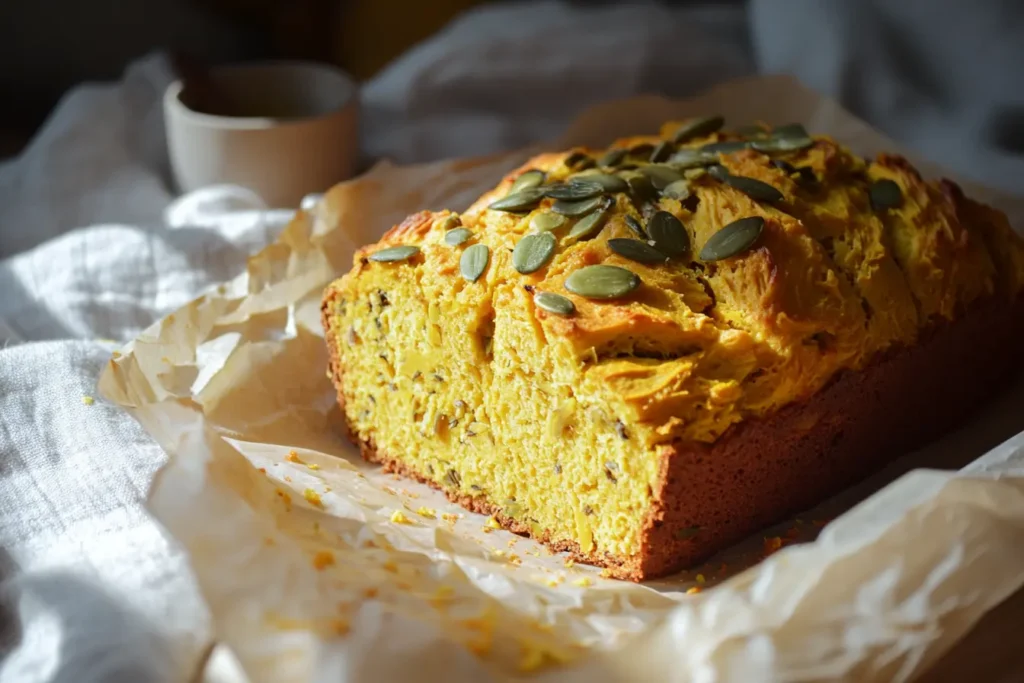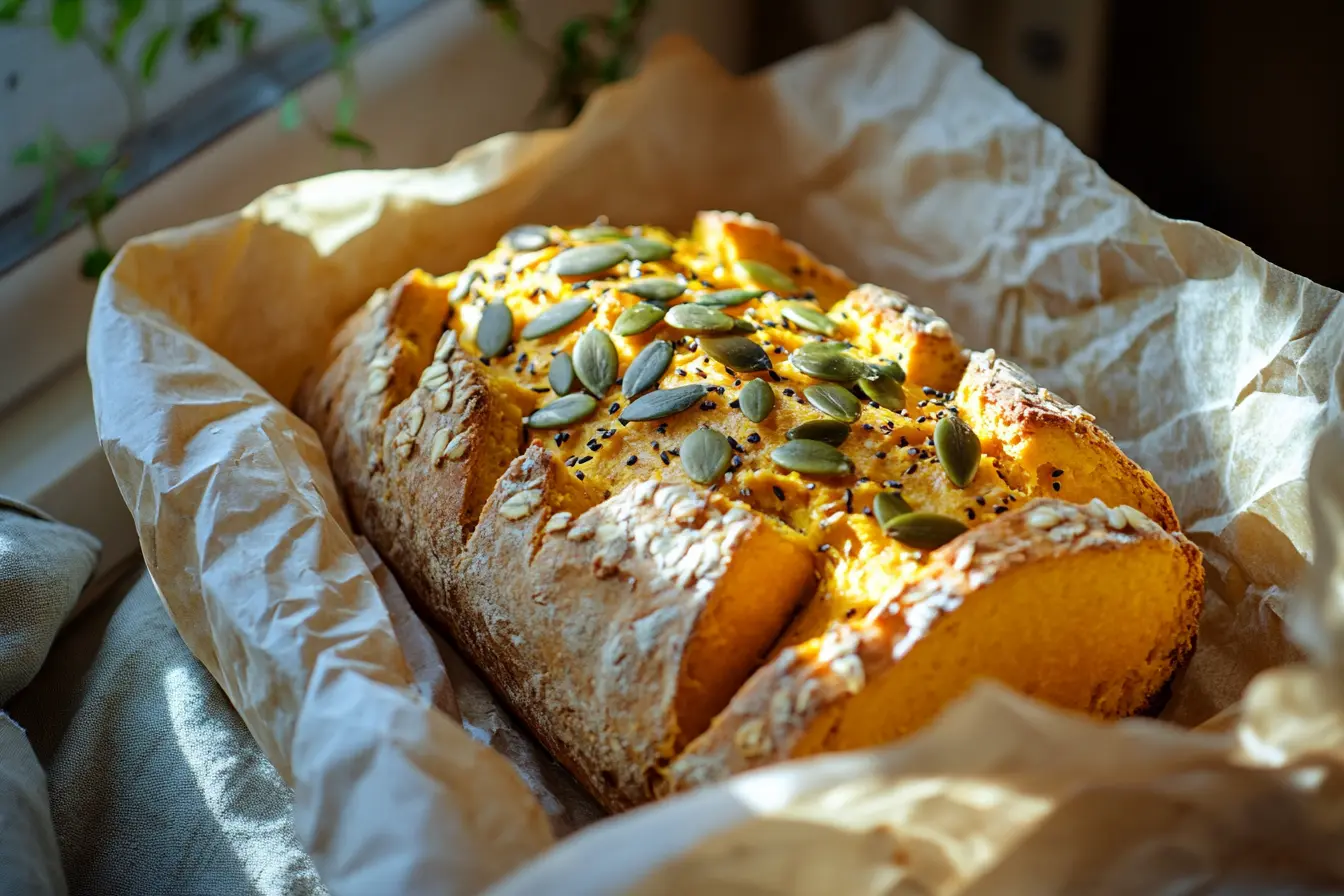Introduction
Get ready to enjoy a mix of Asian tastes and classic bread-making with this Seeded Miso Sweet Potato Bread recipe. This homemade loaf has a rich umami flavor and the sweetness of roasted sweet potatoes. It’s packed with nutrients and has a unique taste that will make your baking better and satisfy your cravings for something special.
Key Takeaways
- Discover the art of incorporating miso, a fermented Japanese seasoning, into your bread-making process.
- Learn the science behind miso fermentation and how it enhances the flavor and texture of your homemade bread.
- Explore the different types of miso and their unique properties for optimal baking results.
- Uncover the secrets to achieving the perfect sweet potato preparation for your Seeded Miso Sweet Potato Bread.
- Master the dough mixing technique and troubleshoot common bread-making issues for a flawless loaf.
Understanding Miso’s Role in Artisanal Bread Making
Miso paste is a key ingredient in artisanal bread making. It comes from fermented soybeans and adds a unique savory umami flavor. This flavor can change the taste and texture of homemade breads. Let’s explore the science behind miso fermentation and how it can improve your baking.
The Science Behind Miso Fermentation
The fermentation of miso is a complex but interesting process. A mix of soybeans, rice or barley, and a starter called “koji” are fermented for months to years. This slow process breaks down proteins and carbs, creating savory umami flavors.
How Miso Enhances Bread Flavor
Miso adds a unique flavor to bread dough. It brings a mix of amino acids, organic acids, and other compounds. These interact with other ingredients, creating a balanced taste. This can make your bread stand out in the artisanal market.
Types of Miso for Baking
- White Miso: Lighter in color and flavor, with a milder, sweet-savory profile that works well in delicate breads.
- Yellow Miso: Slightly more robust in flavor, with a slightly saltier and more complex taste, suitable for hearty breads.
- Red Miso: The most intense in flavor, with a bold, savory umami punch that can add depth to richer, more robust bread recipes.
When picking a miso for your bread, think about the flavor you want. Choose the type that fits best with your recipe’s ingredients.
Essential Ingredients for Seeded Miso Sweet Potato Bread
Making the perfect seeded miso sweet potato bread needs careful picking of ingredients. These ingredients must work together to make a tasty and healthy loaf. At the core of this recipe are whole grains and ancient grains. They give the bread a special texture and add lots of important nutrients.
The base of this bread is a mix of flours, like whole wheat flour and spelt flour. These flours are full of dietary fiber, complex carbohydrates, and many vitamins and minerals. To help the bread rise, you’ll also need a lot of miso paste. This fermented seasoning adds a deep, savory flavor and helps the bread rise well.

- Whole wheat flour
- Spelt flour
- Miso paste
- Sweet potatoes
- Assorted seeds (e.g., sunflower, pumpkin, sesame)
The sweet potatoes add a natural sweetness and lots of vitamins, minerals, and antioxidants. Also, adding nutrient-dense seeds like sunflower, pumpkin, and sesame seeds gives a nice crunch. They also add healthy fats, protein, and fiber.
By mixing these key ingredients, you can make a seeded miso sweet potato bread that looks great and tastes amazing. It’s also packed with nutrients.
The Perfect Sweet Potato Preparation Method
For a delicious sweet potato bread recipe, the sweet potatoes must be prepared right. The right method can change the texture and taste of your healthy baking masterpiece.
Roasting and steaming sweet potatoes have their benefits. Roasting adds a deep sweetness, while steaming keeps the flavor bright. Think about what you like and what you want your sweet potato bread recipe to taste like.
Achieving the Ideal Consistency
To get a smooth sweet potato puree, mash or blend them well. This ensures your healthy baking turns into a moist, tasty bread.
Storage and Prep Tips
- Roast or steam sweet potatoes ahead and keep them in the fridge for up to 3 days.
- Mash or puree the cooked sweet potatoes before adding them to your sweet potato bread recipe batter.
- Use the right amount of sweet potato puree to keep your dough balanced.
Learning how to prepare sweet potatoes well will help you bake a wonderful healthy baking loaf of sweet potato bread recipe. Your family and friends will surely enjoy it.
Seeded Miso Sweet Potato Bread Recipe
Take your baking to the next level with this seeded miso sweet potato bread recipe. It combines miso’s savory taste with sweet potatoes’ natural sweetness. This homemade bread is a treat for your taste buds and a healthy choice for your diet.
To start, gather these ingredients:
- 2 cups all-purpose flour
- 1 cup whole wheat flour
- 1 teaspoon baking soda
- 1/2 teaspoon salt
- 1/2 cup miso paste (preferably yellow or white miso)
- 1 cup mashed roasted sweet potatoes
- 1/2 cup unsweetened almond milk
- 1/4 cup maple syrup
- 1/4 cup melted coconut oil
- 2 tablespoons mixed seeds (such as sesame, flax, and sunflower seeds)
To make the seeded miso sweet potato bread, preheat your oven to 375°F (190°C). Grease a 9×5-inch loaf pan. In a big bowl, mix the all-purpose flour, whole wheat flour, baking soda, and salt. In another bowl, mix the miso paste, mashed sweet potatoes, almond milk, maple syrup, and melted coconut oil until smooth.
Slowly add the wet ingredients to the dry ingredients. Don’t overmix. Put the batter in the loaf pan and sprinkle the seeds on top. Bake for 45-55 minutes, or until a toothpick comes out clean. Let it cool in the pan for 10 minutes before cooling it completely on a wire rack.
This vegan baking treat is great for breakfast, snacks, or with your favorite dishes. It’s a delicious mix of flavors and healthy ingredients. Enjoy baking!
Mastering the Dough Mixing Technique
Making the perfect baked goods, like the seeded miso sweet potato bread, needs skill in dough mixing and kneading. Knowing the right techniques is key to getting the right texture and rise.
Proper Kneading Methods
Good kneading is essential for building the gluten in your dough. This makes the bread chewy and airy. Here are some kneading tips:
- Use a gentle, rhythmic motion, pushing the dough away from you with the heel of your hand, then folding it back towards you.
- Apply just enough pressure to stretch and develop the gluten, without overworking the dough.
- Knead for 5-10 minutes, until the dough becomes smooth, elastic, and passes the “windowpane test” – when a small piece can be stretched thin without tearing.

Visual Cues for Perfect Dough
Getting the dough consistency right is key for your baked goods. Look for these signs to know your dough is ready:
- The dough should have a soft, pliable texture that springs back when poked.
- It should be slightly tacky to the touch, but not overly sticky or wet.
- The surface of the dough should be smooth and uniform, without any dry, crumbly spots.
Troubleshooting Common Issues
If your dough isn’t right, here are some common problems and solutions:
- Dough is too dry and crumbly: Add a tablespoon of water, one at a time, and knead until the dough becomes soft and pliable.
- Dough is too sticky and wet: Sprinkle a small amount of flour on the work surface and knead the dough until it reaches the desired consistency.
- Dough is tough and difficult to knead: Your gluten may be overworked. Let the dough rest for 10-15 minutes, then try kneading again with a lighter touch.
By mastering these dough mixing and kneading techniques, you’ll be well on your way to creating the perfect loaf of healthy baking goodness.
Best Seeds and Grains for Your Bread
Take your homemade Seeded Miso Sweet Potato Bread to the next level with the right seeds and grains. Choose whole grains and ancient grains for amazing flavor, texture, and health benefits.
Sunflower seeds add a nice crunch and a nutty taste that complements the miso and sweet potato. Chia seeds not only look great but also add omega-3s and fiber, making your bread healthier.
- Sunflower seeds
- Chia seeds
- Quinoa
- Amaranth
- Millet
Adding ancient grains like quinoa, amaranth, and millet brings more goodness to your bread. They add texture and boost the bread’s nutritional value.
The charm of whole grains and ancient grains is their flexibility. Try different combinations to match your taste and dietary needs. This way, you’ll make a truly special and healthy baking experience with your Seeded Miso Sweet Potato Bread.
Baking Tips for the Perfect Loaf
Baking the perfect baked goods is more than just a recipe. To get a crisp crust and a moist inside, follow these tips for your savory umami-infused Seeded Miso Sweet Potato Bread.
Temperature and Timing Guidelines
For a great bake, keep the oven at the right temperature and time. Set your oven to 400°F to 425°F. Start with 30-35 minutes of baking. Watch the loaf closely.
The bread is done when the crust is golden and a toothpick comes out clean.
Creating the Ideal Crust
To get a crisp crust, try these methods:
- Brush the loaf with a beaten egg or milk before baking for browning.
- Sprinkle seeds or grains on top for crunch.
- Use a baking stone or steel for even heat and a great crust.
- If the crust browns too fast, cover it with foil to prevent over-browning.
Getting the perfect crust is about finding the right balance. With practice, you’ll make baked goods with a savory umami twist that will wow everyone.
Storage and Serving Suggestions
Keeping your homemade seeded miso sweet potato bread fresh and flavorful is important. This ensures you get the most out of its savory umami taste. Here are some tips to help you store your artisanal loaf:
- Store the bread at room temperature in a paper or linen bag for up to 3 days. Avoid plastic bags, which can trap moisture and cause the crust to soften.
- For longer storage, wrap the bread tightly in plastic wrap or foil and refrigerate for up to 1 week. Bring to room temperature before serving.
- Freeze sliced or whole loaves in airtight bags or containers for up to 3 months. Thaw at room temperature before enjoying.
The seeded miso sweet potato bread is perfect for many uses. You can use it as a base for savory sandwiches. Top it with your favorite cheeses and spreads. Or, dip it in soups and stews to enjoy the umami flavors.
For a quick and tasty snack, toast a slice and drizzle with honey or jam.
| Storage Method | Shelf Life |
|---|---|
| Room Temperature (paper/linen bag) | Up to 3 days |
| Refrigerated (wrapped in plastic/foil) | Up to 1 week |
| Frozen (airtight bags/containers) | Up to 3 months |
Conclusion
The seeded miso sweet potato bread recipe you’ve just explored is amazing. It shows how healthy, homemade baking can be incredible. It combines the rich taste of miso with the natural sweetness of roasted sweet potatoes.
This artisanal bread is a delightful and nutritious twist on traditional loaves. It’s perfect for anyone who loves vegan baking or wants to eat healthier. The mix of seeds, grains, and miso gives it a satisfying texture and a unique flavor.
So, give this seeded miso sweet potato bread recipe a try. It’s a great way to start making artisanal bread at home. With a bit of practice, you can make your own special bread that’s full of flavor and goodness.
FAQ
What is the role of miso in this seeded miso sweet potato bread recipe?
Miso is a fermented soybean paste that’s key in this bread recipe. It adds a savory depth that balances the sweet potatoes’ sweetness. Miso also helps with the bread’s texture by aiding in fermentation and leavening.
What types of miso are best suited for baking bread?
Use white, yellow, or light brown miso for baking. These milder types won’t overpower the other flavors. Darker, more pungent miso can overwhelm the bread’s taste.
How do I properly prepare the sweet potatoes for this recipe?
Roasting sweet potatoes is best for this recipe. It enhances their natural sweetness and flavor. Make sure to mash them until smooth before mixing with the dough.
What types of seeds and grains work well in this seeded miso sweet potato bread?
Seeds like sesame, sunflower, and flax, along with grains like quinoa and millet, are great. They add crunch and boost the bread’s nutrition.
How do I achieve the perfect crust on my seeded miso sweet potato bread?
Bake at 425°F (220°C) for the first 15 minutes to get a crisp crust. Brushing with water or milk before baking helps with browning. Keep an eye on it to avoid over-browning.
How should I store this seeded miso sweet potato bread?
Store the bread at room temperature in a bread box or paper bag for freshness. Don’t use plastic bags or airtight containers to prevent sogginess. Leftovers can be frozen for up to 3 months, wrapped well.

